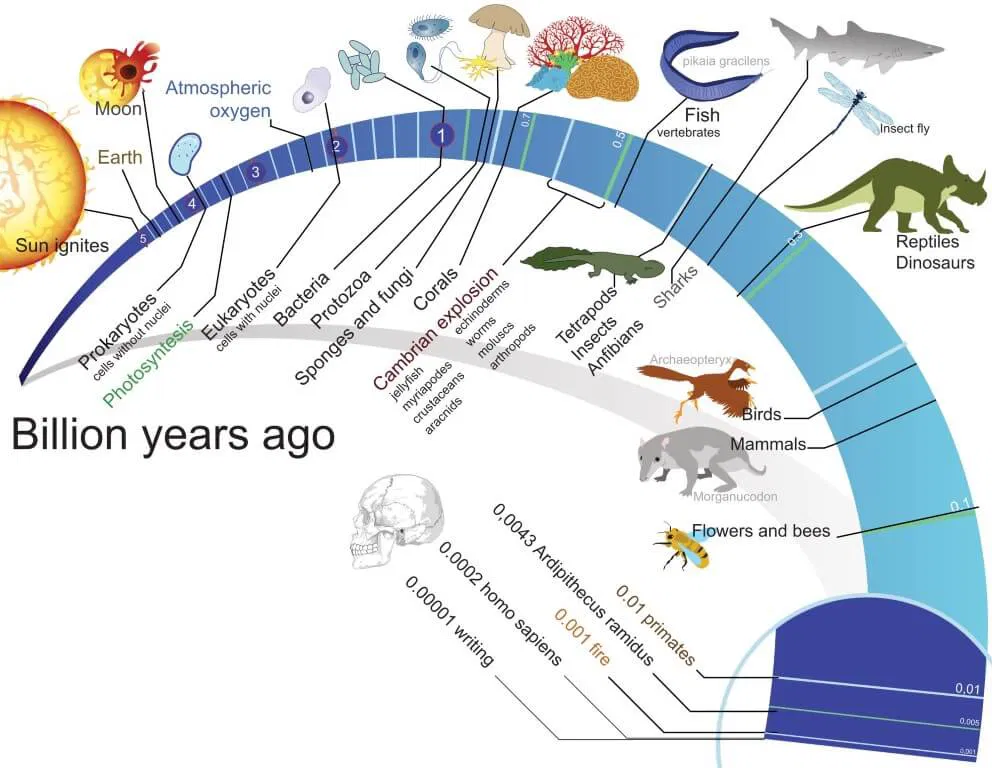Introduction: What Is Evolution?
Evolution is the process by which living organisms change over time through small genetic variations that are passed from one generation to the next. Over millions of years, these changes can lead to the development of new species, the extinction of old ones, and the incredible diversity of life we see today—from bacteria to blue whales, and from moss to humans.
But how does this process actually work? Let’s walk through it—step by step.
Step 1: Life Begins – The First Spark
Our story starts about 3.8 billion years ago, when the first simple life forms appeared on Earth.
- These were single-celled organisms, similar to modern-day bacteria.
- They likely formed in the primordial oceans, possibly near hydrothermal vents or shallow pools.
- These cells had the ability to reproduce, though imperfectly. Each time they copied themselves, there were tiny changes—mutations.
These small mutations were the raw material for evolution.
Step 2: Variation – The Foundation of Change
Not all individuals in a species are identical.
- Some might be a bit faster.
- Some might be more resistant to heat or drought.
- Some might have a slightly different structure in their cell wall or body.
These random variations occur due to mutations in DNA and recombination during reproduction (especially in sexual reproduction).
Variation is essential, because it allows natural selection to “choose” which traits are helpful.
Step 3: Natural Selection – Nature’s Filter
Imagine a forest full of mice. Some have light-colored fur, others dark.
If a volcanic eruption covers the forest in dark ash:
- The dark-furred mice become harder for predators to spot.
- The light-furred mice get eaten more often.
Result? Over generations, more dark-furred mice survive and reproduce.
This is natural selection—the process by which organisms better adapted to their environment survive and pass on their genes.
Key idea:
Traits that help an organism survive and reproduce tend to increase in the population.
Step 4: Adaptation – Shaping the Body and Brain
Over time, natural selection leads to adaptations—features that help organisms thrive.
Examples:
- Long necks in giraffes help reach tall trees.
- Webbed feet in ducks help them swim.
- Camouflage in insects helps avoid predators.
Adaptations can be:
- Physical (like fur color)
- Behavioral (like migration)
- Physiological (like the ability to digest certain foods)
Species become more and more suited to their particular niche—the role they play in their ecosystem.
Step 5: Speciation – When One Becomes Two
Sometimes, members of a species get separated—by mountains, rivers, or migration.
- Over time, isolated populations evolve separately.
- Their traits begin to differ due to different environments or genetic drift.
- Eventually, they become so different that they can no longer breed with each other.
This is called speciation—the formation of new species.
Classic example:
Darwin’s finches on the Galápagos Islands. Each island had its own species of finch, with beaks adapted to different types of food.
Step 6: Extinction – Nature’s Reset Button
Not all species survive.
- Some can’t adapt fast enough to changing environments.
- Others are wiped out by natural disasters or competition.
This leads to extinction—the permanent loss of a species.
In fact, 99% of all species that have ever lived on Earth are now extinct.
But extinction is also part of evolution—it opens up new opportunities for other species to rise.
Example:
The extinction of the dinosaurs (except for birds) gave mammals the chance to diversify and eventually dominate the land.
Step 7: Human Evolution – A Special Branch
Humans are part of this evolutionary story too.
- Our ancestors were ape-like primates living in Africa around 6–7 million years ago.
- Over time, they developed:
- Upright walking
- Larger brains
- Tool use
- Language and culture
Species like Homo habilis, Homo erectus, and finally Homo sapiens (modern humans) emerged.
We didn’t evolve from chimpanzees—we share a common ancestor with them. That ancestor lived about 6 million years ago.
Human evolution is still ongoing. Our brains, bodies, and even resistance to diseases are still changing.
Step 8: Evolution Today – Still Happening
Even today, evolution continues.
- Bacteria evolve resistance to antibiotics.
- Pesticide-resistant insects emerge in farms.
- Climate change is pushing species to adapt or move.
Evolution is not something that only happened in the past. It’s a living, ongoing process—all around us.
Summary: The Evolutionary Timeline
- 3.8 billion years ago – First life appears (single cells)
- 2 billion years ago – Complex cells evolve
- 600 million years ago – Multicellular life forms
- 500–400 million years ago – Plants and animals move to land
- 250 million years ago – Age of reptiles and dinosaurs
- 65 million years ago – Dinosaurs go extinct; mammals rise
- 2 million years ago – Genus Homo evolves
- 300,000 years ago – Modern humans (Homo sapiens) emerge
5 Great Books to Learn More About Evolution
Here are some well-regarded, beginner-to-intermediate level books to deepen your understanding:
- “Why Evolution Is True” by Jerry A. Coyne
A clear, accessible explanation of the evidence for evolution. - “The Selfish Gene” by Richard Dawkins
A groundbreaking book on how genes drive evolution, especially useful for understanding natural selection. - “Your Inner Fish” by Neil Shubin
Explores how our bodies carry evidence of our evolutionary history—from fish to humans. - “The Greatest Show on Earth” by Richard Dawkins
Offers a compelling, evidence-based narrative for evolution for non-scientists. - “Evolution: The Triumph of an Idea” by Carl Zimmer
A beautifully written, illustrated book that blends science, history, and philosophy.
Final Thoughts
Evolution isn’t just a theory—it’s the story of how all life on Earth came to be. It explains why there are so many different plants, animals, and ecosystems. It helps us understand ourselves, our past, and even our future.
By learning evolution step by step, we gain not just knowledge, but a deep appreciation for life’s complexity and beauty.

